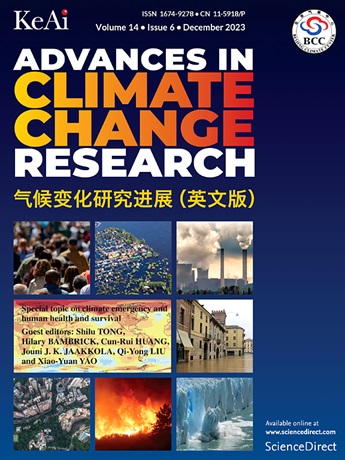中国重点社会经济部门和生态系统适应气候变化技术发展
IF 5.2
1区 地球科学
Q1 ENVIRONMENTAL SCIENCES
引用次数: 0
摘要
适应技术在实现适应目标方面发挥着至关重要的作用,但适应技术的发展仍然缺乏组织和系统。为了有效地支持适应行动的实施,迫切需要促进适应技术的创新。在本研究中,首先从中国的四份气候变化国家评估报告中收集适应技术,创建一个技术列表。然后将适应技术分为四个部分:减少气候危害、减少暴露、降低脆弱性和增加适应能力。这些类别进一步适用于农业、生态系统、水资源、人类健康和能源等部门。将四份国家评估报告中存档的适应技术与中国气候变化科技专项规划提出的发展目标进行对比,发现中国的适应技术虽然有所丰富,但仍存在较大差距。这些差距是由于适应技术在不同社会经济部门的发展不平衡,这些技术缺乏整合到一个系统的一揽子计划中,以及适应技术的属性与气候风险水平之间的联系薄弱造成的。我们建议以有效降低气候风险为主要目标,在适应理论机制的基础上发展适应技术体系。适应技术系统的框架应该是全面的,考虑到适应和减缓之间的协同作用。该框架还应具有逻辑层次,以跨越多个时空尺度解决气候变化带来的机遇和危险,同时捕捉各部门之间的联系。增量适应和转型适应应被视为适应技术体系的两个基本类别,各自对应不同的气候风险水平。本文章由计算机程序翻译,如有差异,请以英文原文为准。
Climate change adaptation technology development of key socioeconomic sectors and ecosystem in China
Adaptation technology plays a crucial role in achieving adaptation goals, but its development remains disorganised and unsystematic. To efficiently support the implementation of adaptation actions, fostering innovation in adaptation technology is urgently needed. In this study, adaptation technologies were firstly collected from China's four National Assessment Reports on Climate Change to create a technology list. The adaptation technologies were then categorised into four components: reducing climatic hazards, diminishing exposure, decreasing vulnerability and increasing adaptive capacity. These categories were further applied to sectors such as agriculture, ecosystem, water resources, human health and energy. Comparison results of the archived adaptation technologies in the four National Assessment Reports, with the development targets outlined in China's Special Science & Technology Plan on Climate Change, revealed that while adaptation technologies have been enriched in China, substantial gaps remain. These gaps arise from an imbalance in the development of adaptation technologies across different socioeconomic sectors, a lack of integration of these technologies into a systematic package and weak linkages between the attributes of adaptation technologies and climate risk levels. We propose that the adaptation technology system should be developed based on the theoretical mechanisms of adaptation, with the main goal of efficiently reducing climate risk. The framework for the adaptation technology system should be comprehensive, considering the synergy between adaptation and mitigation. The framework should also be constructed with logical layers that address opportunities and dangers from climate change across multiple spatiotemporal scales, while capturing the nexus between various sectors. Incremental and transformational adaptation should be considered as two basic categories of the adaptation technology system, each corresponding to different climate risk levels.
求助全文
通过发布文献求助,成功后即可免费获取论文全文。
去求助
来源期刊

Advances in Climate Change Research
Earth and Planetary Sciences-Atmospheric Science
CiteScore
9.80
自引率
4.10%
发文量
424
审稿时长
107 days
期刊介绍:
Advances in Climate Change Research publishes scientific research and analyses on climate change and the interactions of climate change with society. This journal encompasses basic science and economic, social, and policy research, including studies on mitigation and adaptation to climate change.
Advances in Climate Change Research attempts to promote research in climate change and provide an impetus for the application of research achievements in numerous aspects, such as socioeconomic sustainable development, responses to the adaptation and mitigation of climate change, diplomatic negotiations of climate and environment policies, and the protection and exploitation of natural resources.
 求助内容:
求助内容: 应助结果提醒方式:
应助结果提醒方式:


